|
A Sparkling Touch of
History
by Bob
Brooke
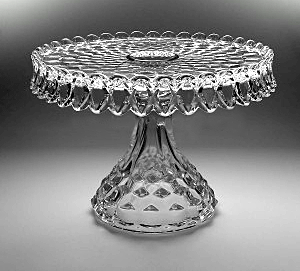 Tucked
away in a modest, three-story Victorian house at 511 Tomlinson
Avenue in downtown Moundsville, Ohio, adjacent to the Marshall
County Courthouse, are some fine examples of nearly a century of
glassmaking by the Fostoria Glass Company. This is the Fostoria
Glass Museum, home to the Fostoria Glass Society. Tucked
away in a modest, three-story Victorian house at 511 Tomlinson
Avenue in downtown Moundsville, Ohio, adjacent to the Marshall
County Courthouse, are some fine examples of nearly a century of
glassmaking by the Fostoria Glass Company. This is the Fostoria
Glass Museum, home to the Fostoria Glass Society.
The Fostoria Glass Company began operations in Fostoria, Ohio, on
December 15, 1887. Natural gas was a desirable fuel for glassmaking,
and during the 1880s, many firms set up shop in northwestern Ohio to
take advantage of this newly discovered resource. Fostoria chose to
build its first plant in Fostoria, Ohio. The firm also received
incentives of $5,000 to $10,000 cash from the city. In the
beginning, the factory’s furnace had a capacity of 12 pots, and
originally employed 125 workers.
Unfortunately for the area glass factories, Northwest Ohio's gas
boom didn’t last long. Gas shortages began during the winter of
1890–91. By April 1891, Fostoria Glass executives decided to move
the company to Moundsville, West Virginia, which they chose because
of the availability of coal as a fuel for the plant—plus a
$10,000-cash incentive offered by the community.
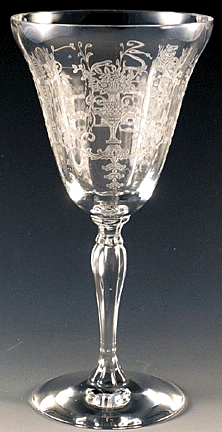 The
company's original Moundsville glass works had a furnace that could
fire 14 pieces of glass at a time. During the firm’s early years
from 1887 through 1909, Fostoria advertised that it manufactured
"tableware, colognes, stationers' glassware, and candelabra", as
well as inkwells, sponge cups, vases, fingerbowls, and fruit jars.
Workers needle etched or wheel cut many of the stemware designs,
popular styles during the early 20th century. The
company's original Moundsville glass works had a furnace that could
fire 14 pieces of glass at a time. During the firm’s early years
from 1887 through 1909, Fostoria advertised that it manufactured
"tableware, colognes, stationers' glassware, and candelabra", as
well as inkwells, sponge cups, vases, fingerbowls, and fruit jars.
Workers needle etched or wheel cut many of the stemware designs,
popular styles during the early 20th century.
During its first 10 years, Fostoria made pressed ware, but early in
the 20th century Fostoria realized the importance of developing fine
quality blown stemware. Fostoria's best-selling pattern was
American, introduced in 1915 and continued until 1983 when the
factory finally closed. It’s remarkable 68-year run makes American
the longest continually produced pattern in the domestic glassware
industry. Fostoria’s early tableware pieces, including these early
American items, were generally either needle etched or wheel cut.
By 1920, Fostoria had expanded to a large factory with five
furnaces, producing stemware, decorative lamps, container glass, and
tableware.
In 1924, Fostoria expanded its product line by introducing colored
glassware. The inaugural colors included green, amber, blue, and
canary. The colors were a huge hit, and, with the strength of a
national advertising campaign behind it, Fostoria products began
appearing in influential magazines like “Good Housekeeping” and
“Ladies’ Home Journal.”
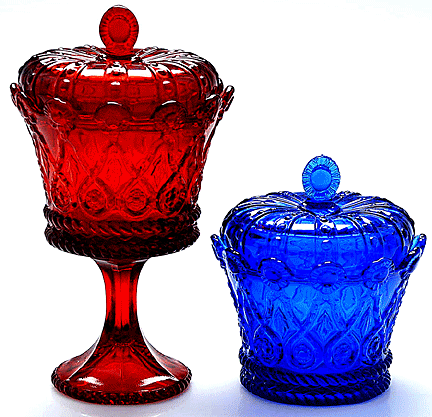 Colored
glassware fit snugly into the market—due to the rise of industry and
the workdays it entailed, fewer American families were having
luncheons and afternoon teas than in the 19th century. Instead,
brunches and after work cocktails had come increasingly into style,
and Fostoria’s colored wares were perfect for casual entertaining. Colored
glassware fit snugly into the market—due to the rise of industry and
the workdays it entailed, fewer American families were having
luncheons and afternoon teas than in the 19th century. Instead,
brunches and after work cocktails had come increasingly into style,
and Fostoria’s colored wares were perfect for casual entertaining.
In 1925, Fostoria employed 650 workers and was second only to
Cambridge Glass Company. Building on its success, the company
expanded its product line to include container glass and decorative
lamps, before adding colored stemware and dinnerware in new colors,
including orchid (1927); rose and azure (1928); and regal blue,
empire green, and burgundy (1933).
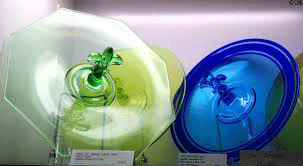 Fostoria
survived the Great Depression producing Depression Glass, and World
War II producing milk glass, and added Chintz (1940), Colony (1940),
Romance (1942), and Holly (1942) to its growing line of patterns.
These followed on the heels of the distinctive Baroque style,
featuring a signature fleur-de-lis in its design, introduced in
1937. Fostoria
survived the Great Depression producing Depression Glass, and World
War II producing milk glass, and added Chintz (1940), Colony (1940),
Romance (1942), and Holly (1942) to its growing line of patterns.
These followed on the heels of the distinctive Baroque style,
featuring a signature fleur-de-lis in its design, introduced in
1937.
After World War II came to an end, Fostoria continued to introduce
new patterns, including Century (1950), Rose (1951), Wedding Ring
(1953), and Jamestown (1959).
The firm also began producing two lines of Carnival Glass—Taffeta
Lustre, which included bowls, candlesticks, and console sets, and
its Brocaded designs, which included Brocaded Acorns, Palms, Summer
Garden, and more.
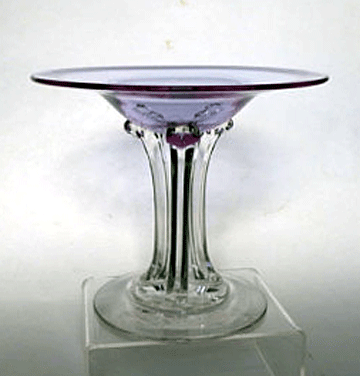 Production
peaked in 1950 when Fostoria manufactured over eight million pieces
of glass and crystal. During that time, it added the crystal
patterns Century (1950), Rose (1951), Wedding Ring (1953), and
Jamestown (1959). In the 1960s and 1970s, the company's marketing
campaign expanded to include boutiques and display rooms within
jewelry and department stores. In addition, Fostoria began
publishing "Creating with Crystal," its own consumer direct
magazine. Production
peaked in 1950 when Fostoria manufactured over eight million pieces
of glass and crystal. During that time, it added the crystal
patterns Century (1950), Rose (1951), Wedding Ring (1953), and
Jamestown (1959). In the 1960s and 1970s, the company's marketing
campaign expanded to include boutiques and display rooms within
jewelry and department stores. In addition, Fostoria began
publishing "Creating with Crystal," its own consumer direct
magazine.
Besides their regular line of blown, etched, and pressure patterns
they did custom work, such as providing glass with government seals
for Washington officials. All the presidents from Eisenhower through
Raegan ordered glassware from them. The museum is a testimony to the
company’s determination to survive in a crowded market.
The Fostoria Museum
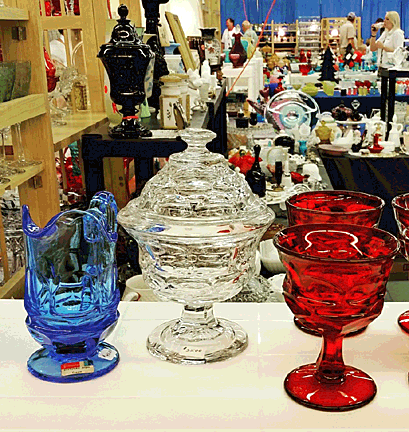 In
1903, Charles and Birdie Burchinal purchased a large portion of the
block bounded by 6th Street and Tomlinson Avenue in Moundsville and
began building a house. Unable to finish the house, the Burchinal's
sold 12 parcels including the lot and house to William H. and Maria
Batson on August 22, 1908. In
1903, Charles and Birdie Burchinal purchased a large portion of the
block bounded by 6th Street and Tomlinson Avenue in Moundsville and
began building a house. Unable to finish the house, the Burchinal's
sold 12 parcels including the lot and house to William H. and Maria
Batson on August 22, 1908.
One year later, Anna Belle Smith or "Ma” Smith as she became known,
purchased the house, had it completed, and moved in with her three
daughters and two sons-in-law. "Ma" Smith owned the house until
1942, after which it served as offices, a residence, and finally as
a Masonic Lodge. The Fostoria Glass Society of America purchased it
between 1988 and 1990.
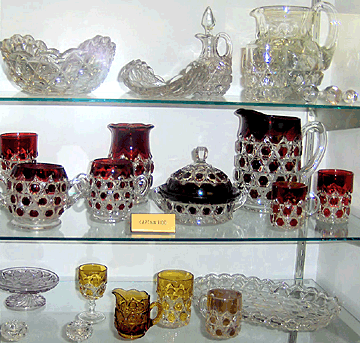 Glass
cases filled with sparkling examples of Fostoria’s finest pieces
fill the rooms of “Ma” Smith’s former home. Butter dishes, cake
plates, relish dishes—all show the wide range of design and styling
that made Fostoria Glass so famous. Glass
cases filled with sparkling examples of Fostoria’s finest pieces
fill the rooms of “Ma” Smith’s former home. Butter dishes, cake
plates, relish dishes—all show the wide range of design and styling
that made Fostoria Glass so famous.
The company’s crowning achievement was its collection of crystal
stemware. Shelf after shelf of these beauties await visitors,
including Fostoria’s Primose Florentine and Meadow patterns.
Sunlight filters through showcases of rainbow of colored glass
featuring many of Fostoria’s most popular patterns, including blue
and red argus pressed glass goblets, candy dishes, and bowls.
Fostoria was particularly known for its candy dishes that graced
many a coffee table.
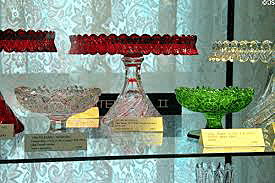 Housewives
placed their delicious homemade cakes on elevated cake plates of
either clear glass or a combination of clear and colored glass. Housewives
placed their delicious homemade cakes on elevated cake plates of
either clear glass or a combination of clear and colored glass.
Jenny Lind by Fostoria is a beautiful milk glass pattern with raised
floral and geometric designs surrounding a cameo of Jenny Lind, a
Swedish opera star. Ladies loved the Jenny Lind perfume bottles.
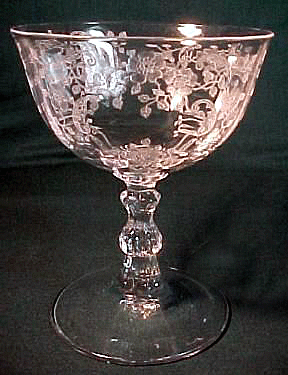 Elegance
was key in Fostoria’s wisteria and crystal tall Art Deco compote
from the 1930s. Delicate etched glass goblets and sherbet glasses
added a touch of elegance to dinner tables of the period. Elegance
was key in Fostoria’s wisteria and crystal tall Art Deco compote
from the 1930s. Delicate etched glass goblets and sherbet glasses
added a touch of elegance to dinner tables of the period.
American crystal ice bowl. Fostoria also produced more solid looking
American pattern milkglass goblets.
The 1950s and 1960s witnessed elegant cut glass crystal figurines.
But as times changed, so did glass styles. The 1960s brought the
free-flow styling of Biscayne and the simple, yet elegant styling of
round and hexagonal luncheon trays.
<
Back to More Antiques to View
Next Article >
|
